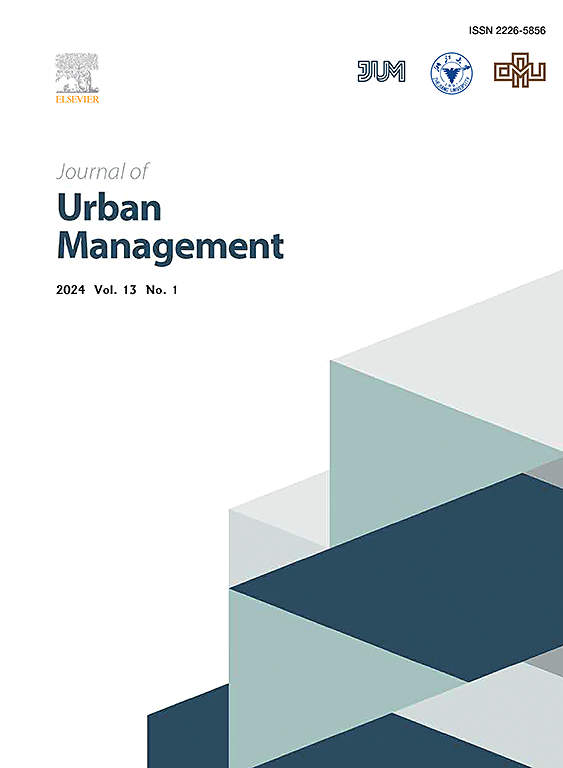建设城市韧性:从2019冠状病毒病大流行中吸取教训,建设面向未来的城市基础设施
IF 5
2区 社会学
Q1 URBAN STUDIES
引用次数: 0
摘要
近年来,新冠肺炎疫情已成为一个日益受到全球关注的全球性问题。随着时间的推移,现有的城市规划设计逐渐受到挑战和改造。世界卫生组织就COVID-19的传播向公众提出了许多建议,其中保持社交距离是主要措施。然而,社会距离政策的实施改变了人们的生活方式。随着大流行持续传播近三年,以及由于疫苗接种率提高而进入大流行后时代,必须考虑调整城市要素,以适应居民不断变化的生活方式。疫情凸显了城市不仅要减少破坏,还要保持功能和宜居性,从而促进经济发展和城市活力。它应用层次分析法根据专家意见选择原则,并相应地构建具体的标准。在此基础上,获得了台北都市圈的关键基础设施(CI)标准及其权重,建立了关键基础设施再分配的顺序。该研究深入探讨了关键基础设施是否应该在大流行后时代重新配置,旨在建立城市抵御能力。通过基于层次分析法的专家问卷调查和矩阵统计计算,得出了真正的重要权重。结果显示,优先级最高的标准是“政策管理”,其次是“建筑环境和公共设施”,第三是“绿蓝基础设施”。这些标准将作为大流行后时代城市设计调整的重要措施,以万华为研究区域,应对公共设施数据分析对城市发展的影响,了解大流行对城市的影响。调查结果旨在为政府单位提供一个框架,以评估和改善重要的城市基础设施,确保城市为未来的健康危机和环境挑战做好更好的准备。本文章由计算机程序翻译,如有差异,请以英文原文为准。
Building urban resilience: Lessons from the COVID-19 pandemic for future-proofing city infrastructure
COVID-19 pandemic has become a global issue of increasing concern in recent years. As time has passed, existing urban planning and design have gradually been challenged and transformed. The World Health Organization has provided numerous recommendations to the public regarding the transmission of COVID-19, with social distancing being the primary measure. However, the implementation of social distancing policies has altered people's lifestyles. With nearly three years of ongoing pandemic transmission and the advent of the post-pandemic era due to increased vaccination rates, it is essential to consider the adjustments of urban elements in response to the changing lifestyles of residents. The pandemic has underscored the need for cities to not only reduce damage but also to maintain functionality and livability, thus enhancing economic development and urban vibrancy. It applies the Analytic Hierarchy Process to select principles based on expert opinions, constructing specific criteria accordingly. Critical Infrastructure (CI) criteria and their weights in the Taipei metropolitan area are then obtained, establishing a sequence for the reallocation of critical infrastructure. The study delves into whether critical infrastructure should be reallocated in the post-pandemic era, aiming to build urban resilience. Through expert questionnaires based on the Analytic Hierarchy Process and matrix statistical calculations, the true importance weights are derived. The results show that the highest priority criteria is "policy management," followed by "built environment and public facilities," and third is "green-blue infrastructure." These criteria will serve as important measures for adjusting urban design in the post-pandemic era, with Wanhua as the study area, to respond to the impact of public facility data analysis on urban development and to understand the pandemic's effects on cities. The findings aim to provide governmental units with a framework to evaluate and improve essential urban infrastructure, ensuring cities are better prepared for future health crises and environmental challenges.
求助全文
通过发布文献求助,成功后即可免费获取论文全文。
去求助
来源期刊

Journal of Urban Management
URBAN STUDIES-
CiteScore
9.50
自引率
4.90%
发文量
45
审稿时长
65 days
期刊介绍:
Journal of Urban Management (JUM) is the Official Journal of Zhejiang University and the Chinese Association of Urban Management, an international, peer-reviewed open access journal covering planning, administering, regulating, and governing urban complexity.
JUM has its two-fold aims set to integrate the studies across fields in urban planning and management, as well as to provide a more holistic perspective on problem solving.
1) Explore innovative management skills for taming thorny problems that arise with global urbanization
2) Provide a platform to deal with urban affairs whose solutions must be looked at from an interdisciplinary perspective.
 求助内容:
求助内容: 应助结果提醒方式:
应助结果提醒方式:


